
The process of necrotization of pulp tissues (the so-called dental “nerve”) in chronic gangrenous pulpitis is preceded by a stage of inflammation, which is the result of a reaction to the action of certain stimuli. Most often, these are bacteria and the toxins produced by them that enter the pulp through the deep carious cavity when there is a perforation of its bottom and communication with the pulp chamber, or through a system of dentinal tubes that pass through the dentin layer. Sometimes an infection can enter the pulp chamber through the periodontal pocket (from under the gums) or enter the bloodstream in infectious diseases, but such a retrograde route of infection without caries is extremely rare.
Chronic gangrenous pulpitis is a consequence of acute diffuse or (rarely) chronic fibrous pulpitis. In the acute stage of inflammation, activation of the body’s immune forces and leukocytes to fight the infection in the pulp are observed,as a result, its edema occurs (an increase in size) and the formation of a liquid: first serous, and then purulent.
The photo below shows the inflamed pulp removed from the tooth even before it has undergone purulent fusion:
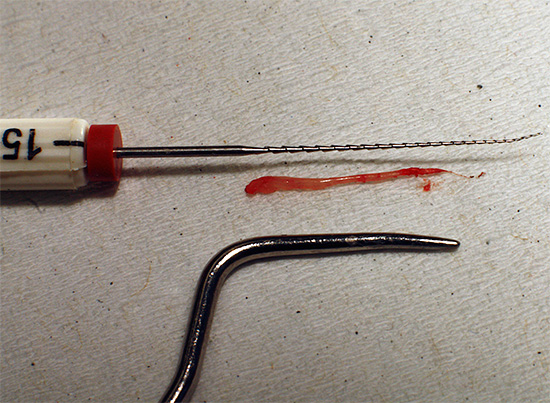
Purulent exudate is nothing but the result of the massive death of white blood cells and bacteria. The accumulation of exudate inhibits the metabolism in the pulp, and it begins to gradually die.
So against the background of acute diffuse pulpitis, the “nerve” disintegrates, which determines the strongest attacks of pain, often spreading along the branches of the nerve to the ear, temple, eye, or back of the head. As soon as the coronal part of the pulp dies and the bottom of the carious cavity is opened with the release of purulent exudate, there is a noticeable relief - the transition acute form in gangrenous pulpitis.
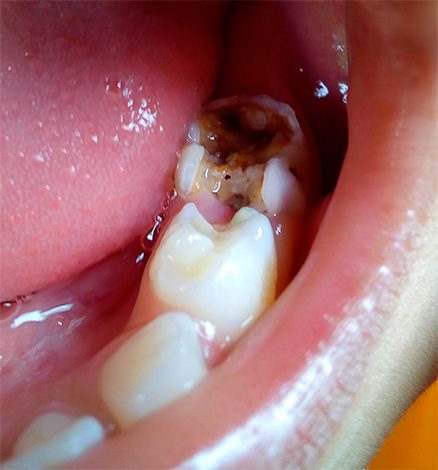
Chronic fibrous pulpitis enters the pulp gangrene only through the acute phase, when, as a result of exudate outflow disturbance (for example, if the floor of the carious cavity is blocked) with food, new foci of abscess form in the nerve tissue, which sooner or later pass into chronic gangrenous pulpitis.
Features of gangrenous pulpitis
Hitting the putrid microflora into the pulp chamber catastrophically influences the further fate of the pulp. The more active the microbes and their toxins, the faster the breakdown (necrosis) of the “nerve” and the death of the coronal part of the pulp with a gradual transition to the root. The name of the disease directly indicates soft tissue gangrene, which determines the characteristic history of the disease in chronic gangrenous pulpitis.

Thus, complaints about the putrid odor of the mouth, aching pains from hot, which persist for a long time even after the removal of the stimulus, most often prevail. There is a feeling of "bursting" inside the tooth, which corresponds to edema of the "nerve" and the slow outflow of exudate from the cavity of the tooth.
If the message carious cavity with the pulp chamber, where the collapsing "nerve" is good and unhindered, then with gangrenous pulpitis there may be no pain symptoms at all. In such cases, the patient indicates only a change in tooth color - the appearance of a grayish tint.
A photograph of a tooth with chronic gangrenous pulpitis — an unhealthy gray tinge is clearly visible:
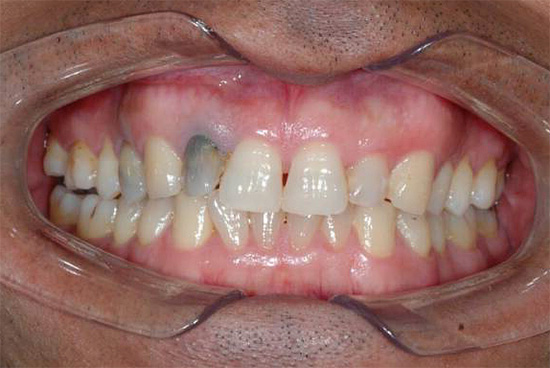
In addition to taking into account the characteristic symptoms of chronic gangrenous pulpitis, the dentist also studies the data of objective research methods in order to make a definitive diagnosis. To do this, a visual inspection of the carious cavity, palpation of the gums near the tooth, sensing and percussion. As an additional method, thermometry, EDI and radiography may be used.
When inspecting a tooth, its gray tint is usually striking in the presence of a carious cavity that goes deep down to the mouths of the root canals. When probing, there is a large amount of carious softened dentin, and deep penetration of the root canal mouth with the sharp end of the probe is often painful, although there is sometimes no pain when a part of the root pulp dies.
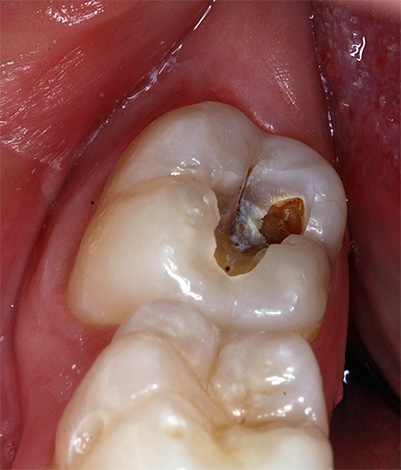
In chronic gangrenous pulpitis, percussion (tapping on the tooth) is most often painless, however, in gangrene of the majority of the pulp and poor outflow of purulent exudate, there may be slight pain. Palpation of the gums in the projection of the apex of the roots of the diseased tooth does not cause pain, as there is no pus out through the tops of the roots in the direction of the gums.
For thermometry, the dentist uses the heated tip of the instrument, since hot water cannot be used to diagnose because of the risk of mucosal burns. Usually, the tip of the dental probe heats up above the burner flame and is gently brought into contact with the coronal part of the tooth for a few seconds.
In the presence of chronic gangrenous pulpitis in this case there is a slow increase in pain, which does not pass for a long time - this indicates the presence of purulent exudate against the background of the collapse of the pulp tissue. Almost does not react to the cold tooth, since most of the "nerve" has already died.
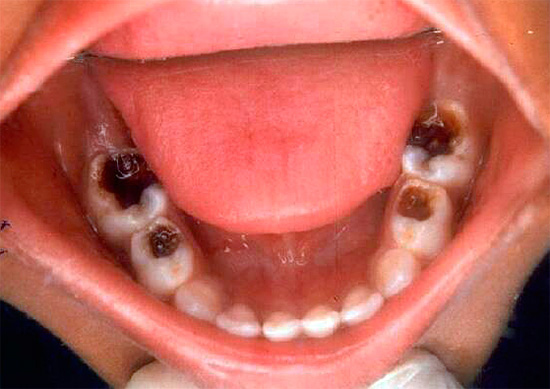
Within the framework of differential diagnostics, EDI can also be used, which is electro-dontodiagnosis, which makes it possible to determine the difference in the excitability of pulp tissues in its various states. Excitability is controlled by a special device with which a weak electric current is passed through a tooth.
A healthy pulp reacts at a current of 2-6 μA, but not more than 20 μA. Gangrene of the pulp reduces the excitability of the nerve to 60-90 μA, depending on the percentage of cell death in the coronal part of the pulp and in the channels.
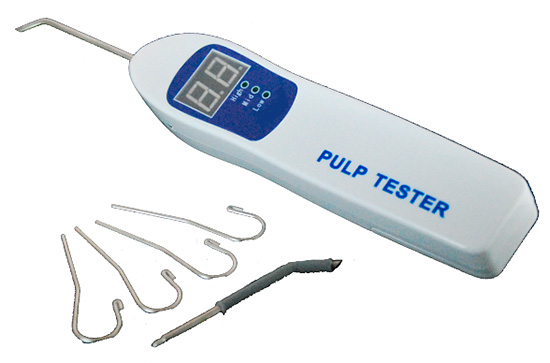
For more information in chronic gangrenous pulpitis, the doctor receives a radiography of the tooth. A modern device - a visiograph allows not only to get a contrast and clear image of all the structures of the tooth and its surrounding tissues, but also to record this data on a computer disk.
In a photograph or monitor of a computer in a sore tooth, a deep carious cavity is usually visible, which communicates well with the pulp chamber. Sometimes with chronic gangrenous pulpitis, changes in the tissues surrounding the tooth are recorded, for example, expansion of the periodontal gap or slight destruction of the bone tissue around the apex of the tooth root.
Methods of treatment of gangrenous pulpitis
The main method of treatment of gangrenous pulpitis is the so-called vital extirpation or, in simple terms, the complete removal (extraction) of the entire pulp from the root canal system. Since this form of pulpitis is irreversible, the biological treatment method (conservative) is not suitable, since there is nothing left to keep in a viable state.
For interesting details of the removal of the “dental“ nerve ”, see a separate article:How to remove a nerve from a tooth and what problems may arise..
Photo of pulp residues removed from the root canal:
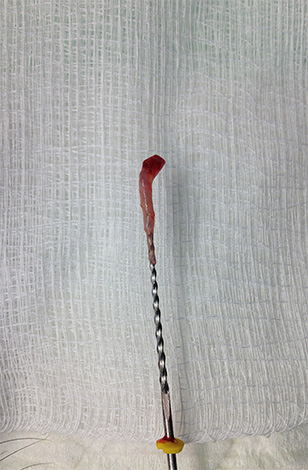
For the same reasons, it is not possible to perform a vital amputation with preservation of only the root pulp, since it is almost always also already involved in the processes of necrosis.
From the experience of the dentist
It is possible to apply the pulp removal method with the preliminary formulation of a devitalizing paste containing and without arsenic, but with great care. Since it is often impossible to accurately determine the depth of the death of the “nerve”, the thoughtless closure of a deliberately almost dead tooth with a potent paste with a bandage often leads to complications in the form of severe pain.
And it is quite logical when it comes to the exudation phase against the background of the putrefactive process. If there are appropriate indications or a desire to install a devitalizing paste on the first visit, you should make sure several times that it will cover even the root part, but the living “nerve”. It is important to keep in mind the criteria for the time it is on the tooth,since the manufacturers of the drugs calculate the average time, considering that almost all the pulp is alive, and in the case of chronic gangrenous pulpitis, an individual approach is required taking into account the amount of soft tissues not affected by necrosis inside the tooth.
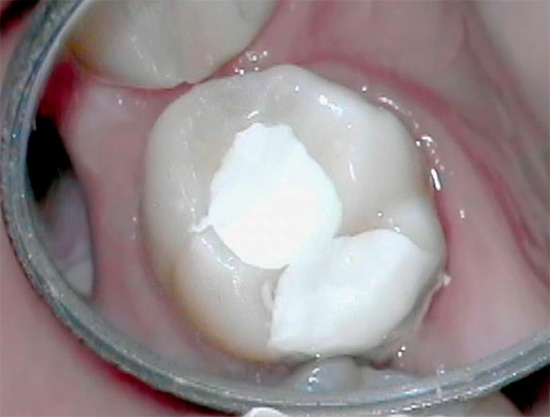
Treatment of chronic gangrenous pulpitis involves several basic steps:
- Anesthesia. If the injection with anesthetic is done at the level (in the projection) of the roots of the diseased tooth, then the anesthesia is called infiltration, and if the entire nervous trunk is “frozen”, then it is conductive.
- Tooth insulation with a cofferdam prior to preparation, or using sterile pre-made or pre-rolled cotton rollers during canal filling and filling.
- Dissection of the carious cavity and mechanical removal of “dirty” infected and pigmented dentin with drug treatment with antiseptics (chlorhexidine, hydrogen peroxide).
- The opening of the mouth of the channel.
- Passing root canals with files (special intra-canal needles with cutting edges), followed by expansion and the formation of a conical shape of the desired diameter.During the procedure, mandatory leaching of residues of pulp, pus, dirty sawdust from the walls, etc. from the channels is performed. Modern dentistry has different methods of “washing” the canals, but the widespread use of gangrenous pulpitis and other types of it has received jet washing with sodium hypochlorite solution.
- Staging of special anti-inflammatory, antibacterial and antiseptic pastes (only by indication) for several days before the final canal filling.
- Determination of the root canal length with special devices (apex locators) or with the help of X-rays using files or gutta-percha pins.
- Drying the canals and filling them with hardening pastes or combining them with primarily hard materials (gutta-percha pins).
- Quality control of canal filling using a viziograph or contact film x-ray.
- Restoration of the function and aesthetics of the tooth with the help of modern filling materials (composites) is almost always carried out in the next visit, since the material in the canals should completely harden within a few days.
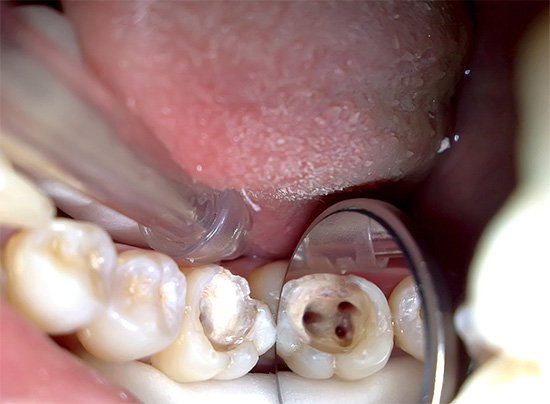
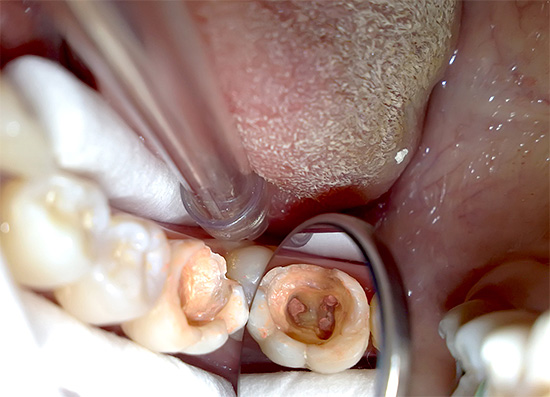


Preparations for the treatment of canals with gangrenous pulpitis
Despite the fact that in chronic gangrenous pulpitis, prolonged channel processing with files and thorough medical treatment with hypochlorite solutions with activation with ultrasound devices and without laser is used, a number of dentists are of the opinion that to prevent residual infection near the root apex and reduce the risk of infection recurrence , should before the final canal filling put anti-inflammatory and potent antibacterial drugs for several days an epic
From the practice of the dentist
For temporary filling of infected channels with gangrenous pulpitis with the aim of increasing sterility, the drug "Gangraena-Merz" is used. This is a material based on calcium hydroxide, which creates a high pH level (up to 12), at which most microbes in the most remote corners of the channels die. However, one should not rely only on the unique positive properties of calcium hydroxide preparations, since an integrated approach is important for preserving a tooth: preliminary thorough cleaning of canals and their irrigation (irrigation) with disinfectant solutions,and only then - the introduction of Gangraena-Merz or its analogues for several days (up to a week).
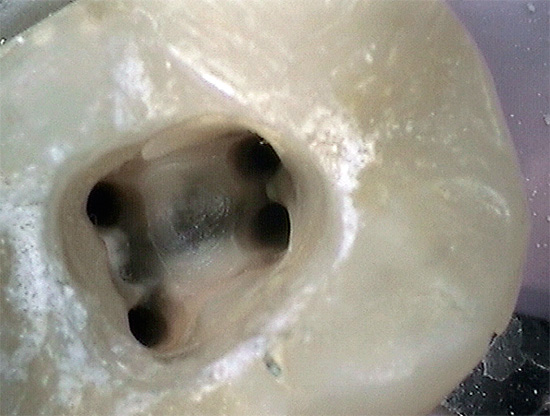
At a budget reception in a hospital or clinic, dentists are not always able to carry out thorough treatment of canals with gangrenous pulpitis in one visit, because the treatment is stretched for 2-3 visits when one or two antiseptic are used in turn. To date, preference in chronic gangrenous form of pulpitis is given not to pastes for the intracanal treatment of pulpitis and periodontitis, but to fluids.
This is a kind of economical option, allowing the use of affordable germicides as long as possible. The most effective and affordable tools include Kresofen.
It is interesting
Cresophen is a bactericidal preparation based on dexamethasone, parachlorophenol, thymol and camphor for effective antiseptic canal treatment. After removing the decay products of the pulp and washing in the usual way, as well as after drying, a drop of Cresophen is placed in each channel. He is able to easily penetrate even difficult-to-passable areas in a short time, creating sterility in them.
To improve and consolidate the results, it is possible to leave Kresofen on cotton turunds for several days under a tight temporary dressing, which creates maximum sterility and ensures the prevention of possible complications due to residual infection. In the next visit, you just need to dry the canals from Cresofen and seal them in an affordable way.

Treatment of gangrenous pulpitis in children
Pediatric dentists are of the opinion that pulp necrosis in baby teeth it is necessary to do everything “in an adult way”: remove the decaying pulp, clean the canals, and flush them from the infection and then seal them in one or several visits. However, children always make their own adjustments not only by their behavior, but also by the characteristics of the structure of milk teeth, the likelihood of not formed and not closed top of the root of the tooth or partially resorbed root during the physiological change of the tooth.
As a result, the children's dentist chooses a method for treating chronic gangrenous pulpitis, based on the individual characteristics of the child,characteristics of a dairy or permanent tooth, as well as the level of equipment of the clinic and their professional skills.

Since it is not possible to choose a biological treatment method and vital amputation due to far-gone pulp tissue necrosis, for milk teeth one can choose either the vital (devital) extirpation method with complete pulp extraction, or the long-time devital amputation method with mummification of the root pulp after it killing.
More often for this purpose, preparations based on resorcin-formalin paste are used. Depending on the specifics of the composition and the manufacturer, they can be more or less toxic, but, in principle, contain the same basic components for the mummification of the dead "nerve" and the preservation of the tooth until its change. Currently, Russia uses the Swiss Mummifying Paste (Mummifying Paste), Foredent (Czech Republic), Rezodent (Russia), Endoform (Poland) and their analogues.
It is interesting
Around 1912, the German physician J. Albrecht proposed the resorcinol-formalin method, the controversy around which has not abated until now. The “father” of one of the most popular and cheapest methods of root canal treatment until the end of his life worked as a dentist, never becoming a professor or even an assistant professor.Little is known about his biography; there is no exact date of birth and death. It is believed that, most likely, the scientist was destroyed by hunger and disease.
Since the creation of the method, there have been controversies around the validity and effectiveness of its use, there have been opponents and supporters among young and old professors and scientists all over the world. For ease of use and low cost, he won the honor of widespread use for all groups of teeth, but no one thought about its negative properties. Tooth staining in shades of pink, until recently, few people were embarrassed, and the prospect tooth extraction in 5-10 years or more did not stop anyone: neither doctors nor patients.
Photo of a tooth cured of pulpitis using resorcin-formalin paste:

Cost of treatment
Chronic gangrenous pulpitis is usually treated in two to three visits. In clinics, pricing is based on the level of the institution, professional equipment, the qualifications of doctors, the number of staff, the method of treatment, the material used, the number of visits and other factors. The price list usually indicates each procedure performed during the course of treatment.
The principle of pricing for the treatment of pulpitis can be traced according to the following standard scheme, in which payment is made for the following steps:
- anesthesia (some firms plus every injection of anesthetic);
- passing and washing each channel separately (if there are 4 teeth in the tooth, then the price for these manipulations increases 4 times);
- filling each channel with a certain material (large companies offer a choice of both “simple” filling with cold gutta-percha with pastes, and three-dimensional sealing with the hot gutta-percha system “Termafil”, which is much more expensive);
- the use of ultrasound or laser to activate antiseptics in the process of processing channels (some companies include this section in payment for the passage and washing of the channels);
- The seal, which completes the treatment (among the light-cured composites there are materials of economy and business class, which is written in the price list).
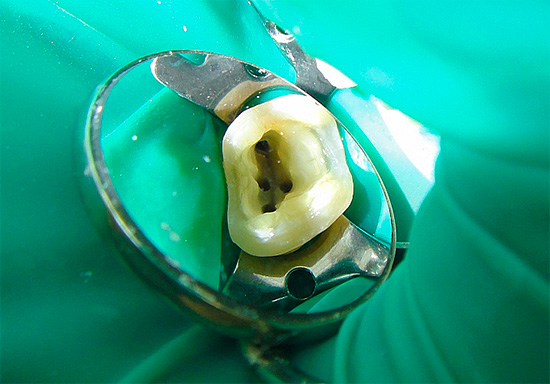
If the dental clinic rates each visit, then each of these sections selectively appears in the receipt for payment of services. Naturally, if it is necessary to pay for a light-cured seal with anesthesia, for example,2-3 thousand rubles, the remaining procedures can result in a tidy sum, since the standard flushing of one channel costs an average of 1000 rubles (for a 4-channel channel, 4 thousand are already obtained).
For additional "options" the company sets the price in an arbitrary way - somewhere more, somewhere less.
It is not difficult to calculate that in one visit, in which all four channels of the molar (upper or lower) with gangrenous pulpitis will be covered and sealed, the cost of treatment will be approximately 7-8 thousand rubles, and the final filling will be 2-3 thousand more, if you take average cost of treatment. In other words, the smaller the channels in the tooth, the cheaper the treatment of pulpitis will cost you.
See for example the nuances treatment of pulpitis three-channel tooth.

In many private clinics, dentists are directly interested in extending the treatment of pulpitis to several visits in order to increase the cost. Moreover, the level of modern dental institutions allows creating so sterile conditions in the canal system and so tightly close the tooth from the external environment until the next visit, that the uselessness of re-washing the canals is obvious to the doctor, but the patient doesn’t even know it.
What the clinic can do in one visit can stretch into several expensive procedures, since chronic gangrenous pulpitis is often positioned for the patient as periodontitis that has begun - inflammation at the root, which should be treated in several visits, using sophisticated technology and necessarily expensive.
In contrast to commercial firms, state budget dentistry, on the contrary, underestimates the importance of canal washing and rarely uses their jet treatment, limited to manual routine washing with antiseptics on cotton wool coats. As always, the most difficult thing is to find some middle ground ...
Be healthy!
Interesting video: an example of the treatment of purulent pulpitis molar (chewing tooth)
Details on the mechanism of development of pulpitis and the features of its treatment.

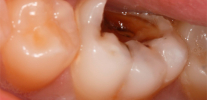

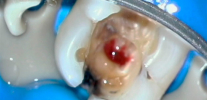
I do not agree that the doctor is interested in stretching the treatment due to material benefits, because it is completely unprofitable! Because what matters is not how much one patient will pay in general, but how much is paid for one visit.
Maybe you did not carefully read the last block: it says that “many private clinics”, but not all. Often received feedback from patients who are wound for each visit, even with pulpitis. I'll keep silence about periodontitis - this is fertile ground for cheating for each new visit.We have a huge country, and where and how it is done, you yourself can find out if you look more closely at the particular private dentistry in different regions.